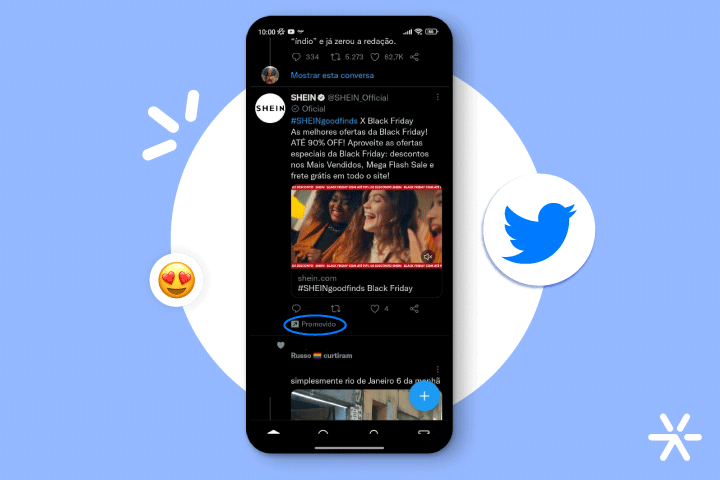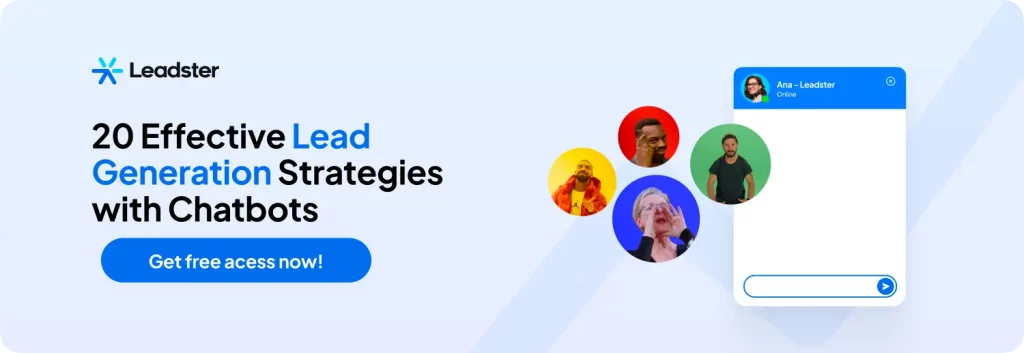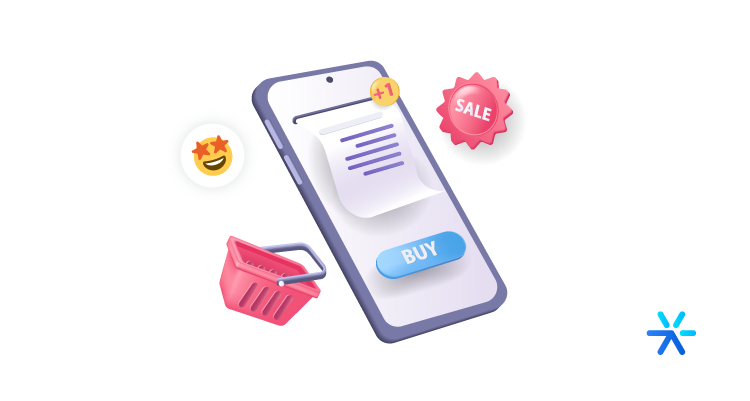Twitter Marketing: An All in One Guide
Is it still worth doing Twitter Marketing? Even with everything that is happening on this social network?
That’s the million dollar question. The now X, formerly Twitter, has experienced some difficulties lately after its sale to billionaire Elon Musk.
Many people say that the purchase was for controversial reasons: Musk got tired of being censored by the platform and decided to buy it to say whatever he wants.
In fact, this is what Musk himself says: in a TED talk, Musk stated that he would like to transform Twitter into a “platform for freedom of expression”; a fact that occurred right before carrying out the transaction, which exceeded US$40 billion.
And, in this case, many marketers ended up watching ships. Twitter, which always had great potential for advertisements and content dissemination, did not inaugurate a viable model.
But and now? All of this happened throughout 2022 and at the beginning of 2023. Time has passed, but has Twitter/X gotten better for advertisers?
Let’s find out now.
Is Marketing on Twitter Still Worth It?
The truth is that Twitter Marketing has never been a very viable strategy for smaller advertisers and small brands, especially in B2B.
The operation of its advertising platform has always been very basic, without offering features that are already a standard in any AdTech — the geographic location of the target audience , for example, was never implemented.
The feeling is that Twitter has always been more aimed at big advertisers and big brands.
This is because, as the ad platform has always had the characteristic of being very basic, its main metric has always been ad impressions, with little attention dedicated to other modalities.
Virtually all other Social Ads are different. Meta Ads, for example, has used geographic location since its first version of ads.
And TikTok Ads itself, which is much newer, also has this function.
It’s important to understand this at the beginning of the text so that you don’t have too high expectations about the results you’ll get on Twitter.
It’s interesting to keep your brand there, but the ads themselves don’t deliver very good results. You need to stand out in other ways.
Let’s talk more about this in the following topic. Let’s see what are the main features that Twitter offers for those who want to do marketing there?
Understanding All the Features of Twitter/X

But let’s go slowly, right? For us to reach a conclusion, we need to dive head first into all the features that Twitter can deliver.
In this part of the text, we’re going to talk about everything that Twitter can offer to advertisers and beyond — brands that don’t necessarily want to advertise, but would like to start simpler engagement work.
There is good news and bad news. The good ones are related to the amount of resources that Twitter already offers today, especially for brands that are just starting out.
The bad ones, however, will agree with what we have been talking about so far. Although these resources exist, they cannot come close to competing with social networks, such as Instagram and Facebook.
In fact, several of these features have already been offered by these other platforms for a good few years and, in some cases, Twitter charges what was always free.
But I don’t want to get ahead of the conversation. Come with me so we can discover together what Twitter Marketing can really offer:
How do ads work?
X’s ads, as we talked about, are still a little limited.
First, we need to understand the accepted formats. They’re the standard you’d expect from any ad platform:
- Image ads;
- Video ads;
- Carousel ads;
- Text ads;
- Moment Ads.
This last type, Moment, allows you to announce an entire thread or a collection of tweets (Xs? Equisses?😅), a very interesting feature.
But these are the most basic ads Twitter offers. There are also some other types:
- Ads for followers: text only. They are displayed as Promoted Tweets on the person’s timeline and as Promoted Accounts in the Who to Follow boxes on the results pages, Home, Profile and Search
- Amplify Pre-Roll: Video functionality for Twitter ads. Insert your brand into popular videos on the platform, in a scheme similar to YouTube Ads;
- Twitter Live: is not a form of advertising, but allows you to create lives within the platform;
- Timeline Takeover: your ad appears at the top of the timeline for users, similar to Google Ads in the Search Network format ;
- Branded Hashtags: you configure an emoji to appear next to a custom hashtag, with a limit of 5 hashtags per emoji;
- Dynamic Product Ads: The closest Twitter can get to Meta remarketing. With the pixel, you take advantage of your website’s first-party cookies to display recommended products according to your followers’ interactions in your e-commerce.
These are the types of ads on Twitter. Some are very useful, others not so much.
Hashtags, for example, are a complete waste of time for small brands. At the same time, they can be interesting for larger companies that want to add an extra branding feature to their messages.
But note that the basics are not included in these ad objectives: geographic location, interest targeting, etc.
This never existed on Twitter, and apparently it never will.
How do verified accounts work?
Verified accounts, Twitter’s famous blue seal, have undergone some pretty drastic transformations.
The first and most obvious is the need for you to join Twitter Premium to get the badge.
Any account, whether an individual or a company, can have access to the Twiiter blue badge , as long as it meets the basic requirements and is subscribed to Premium.
See what these requirements are here.
This is one of the most basic Twitter Marketing strategies, now with less bureaucracy.
Paying to have the blue seal may seem exclusionary, but in fact it is quite the opposite. Very small brands had difficulty getting the verification seal before.
Now, by purchasing Twitter Premium, anyone can have this extra verification.
But the seals don’t stop there:
What are Verified Organizations?
Verified Organizations are a type of verification badge that can be extended to other accounts.
For example: we here at Leadster decided to have a Twitter verification badge. With Verified Organizations, we were able to bring the seal to Leadster and also pass it on to other associated accounts.
Thus, it is possible to create an entire ecosystem of verified accounts on Twitter, improving your overall communication with your followers.
Imagine someone asking for direct support for the brand being answered by another person, with a verified account, working for your brand.
This was the most interesting innovation that Twitter brought after it became X, but also the most expensive. The most basic subscription costs R$200 per month! And it can reach up to R$1,000.
Learn more about this feature by clicking here.
What are the Main Objectives of Marketing at X?

Well, now that we’ve talked about the main points of performance marketing on Twitter, we still need to understand what your stance on the social network should be.
By stance, I mean strategy. What should a brand value there? What are the actions that you should prioritize when starting Twitter Marketing?
Let’s talk a little about them all here. Remembering that Twitter is a very different space from other social networks.
There, tweets rule, not posts. What people respond to often has more impact than what you post.
Therefore, Twitter is all about interaction. But this is a double-edged sword.
Let’s talk more about this below. Follow me on the next items:
Engagement with the public
By far, the greatest potential of Twitter Marketing is in engaging with the public.
You need to find ways to engage your followers, making posts that are within what they usually consume and looking for creative ways to get their attention.
You will need, above all, a very well developed and determined Editorial Identity to avoid communication errors.
There’s no point posting just commercial messages, since no one is looking for that on Twitter.
In fact, few people are looking for this on any social network.
There’s only one universal rule for engaging on Twitter: you have to use Twitter.
And that often. It is only by using it, interacting with your audience, inserting yourself in conversations and bringing relevant positions about your product and segment that you will be able to create a good atmosphere of engagement.
Don’t try to make institutional and corporate posts. They won’t get you anywhere on Twitter.

Possibility of going viral
OX continues to be a great social network for viralizing content.
For many years, any content that went viral went viral first on Twitter.
Today, TikTok already holds this flag, but Twitter still has great potential.
If your brand is different, with a younger language, and especially if you operate in segments that deal with generation Z, it is important to look for opportunities to go viral.
This is only possible if you actually spend a lot of time on Twitter and the Internet in general.
See what’s popular and try to do something similar, or even reuse a trend.
For brands that have never gone viral in their lives, a few hundred thousand views are more than enough to get started on this path.
Content integration
But we can’t define Twitter as a social network focused only on “yay yay”, right?
There are several professional and corporate profiles there. In fact, depending on your algorithmic “bubble”, you may find Twitter much more similar to LinkedIn than TikTok and Instagram.
Because of this, if your content is more focused on B2B or commercial reality, it’s a good idea to promote it on Twitter as well, looking for these more professional profiles.
Start following brands in your segment and see who your followers are. Then, follow these followers too, and use Twitter to curate the content you create in other media.
This includes video cuts, podcast excerpts, launching Lead Magnets , signing up for the Newsletter, latest blog posts, etc.
Brand humanization
The most important and interesting point of Twitter is the opportunity to humanize your brand.
These opportunities come in droves every time you have the chance to interact with someone.
Bots on Twitter are very common, but I would advise you not to work with them.
Bots are the complete opposite of this humanization, and throw away any chance you would have of maintaining humanized contact with your followers.
Always try to respond spontaneously and naturally, even to the most complicated questions.
And believe me: these questions are the most common.
But in practice, what does the Twitter Marketing routine look like? That’s what we’re going to discover now, in the next topic:
How to Start Marketing on Twitter?
Marketing on Twitter is a bit of a thankless task.
This is because the platform is constantly undergoing changes, and it is difficult to know what its future will be from now on.
With the basic monetization models that Elon Musk has been creating, it is very difficult to guarantee a good future for X.
The CEO’s gaze should be focused on the advertisements, which, as we saw at the beginning of the text, are still quite basic.
This is not to say that you shouldn’t invest in Twitter Marketing. In fact, the platform may last for many years. And, in this case, whoever has been involved in it for the longest time wins.
If you really want to invest, the topics below will help you understand how to really get started.
Identifying brand stance
First: what kind of brand will your brand be on Twitter?
This is the main point you need to determine. Will your brand be a reference in your segment or will it be one of those playful brands, Bis and Netflix style?
This point is important for you to determine at the beginning of your strategy. It is only through this definition that you will be able to respond well to all interactions and plan new actions with the potential to go viral.
Not everything on Twitter is a joke. As we saw above, there are true communities around very specific topics, with big brands guiding the conversation.
But if it’s meant to be a joke, that’s okay too!
The important thing is just to determine who you are talking to and what the ideal message is. It seems simple and it really is: it just takes a little work 😅
Escaping controversies and cancellations
At the same time, it is important for us to determine here that it is best to avoid controversies, unless they put you in a good position with your target audience.
For example: if your brand serves an LGBTQIAPN+ audience, it’s worth taking action on Gay Pride Day, but it’s not worth going into other threads and sparking discussions.
At the same time, if your audience is the complete opposite of this, it’s also not worth making a tweet condemning Gay Pride Day.
Does it bring views? It is clear! Twitter lives by this: the more discord, the more views a tweet will have.
But that marketing maxim, “there is no such thing as negative publicity”, was not created in the age of the internet. Nowadays, there is certainly negative advertising, which can and will impact your sales.
And you don’t even know when this problem may arise. Maybe the day after its publication. Maybe 5 years later.
Either way, it’s best avoided. There are several techniques for bringing views to your website within digital marketing and inbound marketing methodologies .
Work with them first. Then think about arguing on Twitter.
Finding opportunities to go viral
How to find the best opportunities to create viral content?
“Viral content is not created, it is spontaneous” — that’s one of the biggest controversies in marketing.
Yes, for one thing, viral content really isn’t planned, it’s completely spontaneous.
But, on the other hand, there are campaigns so well designed that they end up going viral. This was the case with BIS’s latest virality on Twitter.
The brand acquired the naming rights for Morumbi and transformed it into MorumBIS. It went viral instantly and across multiple channels at the same time.
So, you need to keep an eye on all your marketing opportunities, analyzing action by action what has the potential to go viral.
At the same time, always stay alert for opportunities outside of what you are planning! See what’s trending on Twitter and create quick campaigns when you can.
Viralization is spontaneous, but it is controlled spontaneity. You need to be open to opportunities for them to happen.
Seeking partnerships with other brands
Co-branding talks a lot on Twitter. Very high indeed.
As we talked about, Twitter is a social network focused on discussions. Real discord. This is not remotely an attack on Twitter, just a recognition of what it proposes.
Brands that “fight” with each other are always going viral there. And in all cases, without any exception, it’s all co-marketing.
I’m not telling you to look for brands to fight, mind you. Initially, it’s worth looking for other brands in your segment that produce good content on Twitter and trying partnerships of all types.
Even if it’s a few exchanges of posts, or a promotion on a commemorative date, anyway: create the relationship first.
Monitoring and responding every day
This is the most important point in Twitter Marketing: the need to monitor your brand’s performance daily.
I myself would recommend working with someone responsible only for Twitter and nothing else.
This monitoring is important because it is an investment. We already talked here in the text about how crucial it is to be present on Twitter to find good opportunities for action and virality.
When you determine that one person should be responsible for monitoring and responding, you are ensuring more chances of producing better and more optimized content for the social network.
How to Sell Twitter Marketing in your Agency?

Well, we’ve already talked a lot about Twitter Marketing in general and especially the client side — that is, outside agencies and within marketing departments.
But to close the text, I think it’s a good idea for us to talk about the reality of agencies too — especially about how to sell Twitter Marketing work.
There are agencies specializing in Twitter that work with big brands, and these lessons were all taken directly from them.
There are also smaller agencies, which work locally, and which have a more micro view of the work.
These tips also take this into account, and are aimed mainly at this type of agency.
Is this your case? So let’s move on to the items that we still have a lot to talk about.
Oh, and stay with me until the end because I have a great offer to make you.
Let’s go?
Defining plans
First you need to think about the pricing of your service.
Each agency has a different way of working on social media, but Twitter, from what we’ve seen so far, is a little different.
It’s quite complicated to charge for a volume of weekly or monthly posts, as you will probably find content opportunities throughout your work that will exceed these limits.
The best thing is to establish plans. See an example:
- Plan 1: daily monitoring during business hours, with 1,000 interactions per month;
- Plan 2: daily monitoring during business hours, with 5,000 interactions per month;
- Plan 3: daily monitoring 24 hours a day, with no limit on monthly interactions.
With these plans, you are not limiting tweets, but people’s interactions with your brand.
You are the one who decides how to categorize these interactions. Liking other people’s content, replying to messages, it all counts!
The most important thing here is to ensure that you don’t get trapped in your own contract, and miss out on good opportunities to impress your client because of it.
Creating a very secure contract
Doing Twitter Marketing is not a simple task.
You will encounter, in many cases, unexpected situations that can damage the reputation of the brand you are serving by pure accident.
To deal with these cases, I suggest you have a model contract exclusive to Twitter, exempting the agency from liability for content posted on Twitter.
It is common. Agency contracts normally exempt them from negative repercussions from campaigns, as it is impossible to be absolutely sure how the campaign will be received by the public.
Finding the right person for the job
The person who must take care of the customer’s account is a writer, there is no doubt about that.
But at the same time, it is very important to understand that copywriters come from all backgrounds and with various specialties.
You need to look for writers who have proven experience on Twitter, even if that experience is on your own personal account.
People who understand Twitter need to be briefed only on the brand, not on how the platform works as a whole.
Organizing work
And all of this, of course, needs to be very well organized. But very well indeed.
Agencies’ routines are quite hectic, so the organization of such an abstract task, such as Twitter Marketing, ends up being left aside.
But it is important that close monitoring takes place, with daily meetings to understand what is happening in the client’s account.
Don’t forget that copywriters are creative people. If you leave them without guidance and close monitoring, you run the risk of having results that reflect more the writer himself than the brand.
So, what did you think of the idea of starting Twitter Marketing in your company or selling through your agency?
Another very important point to consider when doing this work is what happens if you are successful at everything.
If your Twitter Marketing is good, your followers will start coming to your website. In fact, not only your followers, but also people who have access to your brand on Twitter in general.
So, what happens when they come to your website?
If the answer is “nothing”, here’s a quick diagnosis: you’re having trouble generating leads.
Resolve this situation today with the Leadster chatbot! It automatically generates and qualifies leads on your website, with simple and highly effective flows due to its customization.
Thanks for reading and we’ll see you in the next article!








